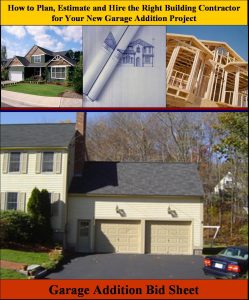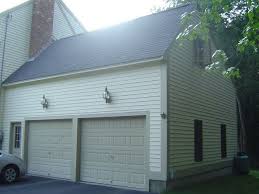A Garage Conversion Project is a great way to add Living Space to Your Home
By Mark J. Donovan
|
|
A garage conversion project is a simple and great way to add 200 to 400 square feet of living space to your home. Frequently garages are converted into bedrooms, bathrooms, and family rooms. Due to the fact that a garage already consists of a foundation, four exterior walls and a roof it is relatively an inexpensive solution for adding more living space to your home, compared to building a brand new home addition.
A garage conversion project has some of the same concerns and problems as finishing a basement. |
There are cold concrete floors and various protrusions and obstructions in both a garage and a basement that must be worked around.
When developing a garage conversion plan there are a number of items you should first consider before actually moving forward with such a project.
Check first with your Local building Inspector
Local residential building code requirements may vary on garage construction versus living space construction. You may want to first check with your local building inspector to determine if there are any structural or zoning issues with converting your garage into a completed living space.
| For example, it may be okay for garage roof trusses to be spaced 24″ apart in your municipality, however local building codes may also specify that these may need to be 16″ on center for formal living space. It is worthwhile talking to your building inspector first before completing a garage conversion plan and hiring contractors. You will need to pull permits anyway, so you might as well learn up front any code issues / restrictions before submitting plans to the building inspector and beginning your project.
Garage Conversion Projects and Plumbing When considering a bathroom, kitchen or wet bar as part of your garage conversion project special upfront attention needs to be paid to plumbing. |

Use this garage addition checklist to save time, money and hassles on your garage project. |
Most garage floors are concrete, and as a result, you typically only have a couple of choices to address plumbing requirements.
You can either cut out swaths of concrete flooring to run drainage pipes or elevate the floor. Elevating a bathroom or kitchen floor is typically less desirable, unless of course you plan on elevating the entire garage floor. I will discuss this issue/concept in more detail later.
The alternative to elevating the bathroom / kitchen floor is to cut out swaths of concrete flooring. This task is extremely messy, dusty, and requires a great deal of hard manual labor, but in the end you will achieve a better product. Consequently, my recommendation is to first consult with a plumber before you develop detail floor plans of your garage conversion project. He can help you decide where the best location is for your bathroom / kitchen / wet bar, and recommend a layout. Ideally you will want to locate the rooms requiring plumbing near each other and near the existing sewer/septic drain pipes within the main home to minimize concrete cutting.
| Once you have completed your garage conversion floorplan, have your plumber mark the locations for where the concrete needs to be cut away. Remove the concrete prior to beginning any other work on the project.
Cutting concrete is an extremely dusty and noisy endeavor so make sure everything is out of the garage prior to cutting. I would also recommend hiring either the plumber or another subcontractor to perform this work. |
 |
Framing in the Garage Door Openings
When converting your garage into formal living space you will probably want to frame in the existing garage door openings. You may want to consider locating a standard door or windows in one or more of these openings as you frame them in.
Cutting new door openings and windows into existing walls is a more expensive effort, as external siding and potentially interior sheetrock will need to be disturbed that may not otherwise be required. If aesthetically and functionally it makes sense, replacing a garage door opening with a standard door and/or windows can potentially save some money.
Also, when framing in the garage door openings, first build up the base of the openings with either concrete or concrete blocks to the same height of the adjacent foundation walls. This will help to ensure a finished external appearance that blends in well with the rest of the home’s siding.
|
Garage Floors Garage floors can be cold. Garage floors typically consist of just an un-insulated concrete pad. Also, frequently garage floors are sloped so that water runs toward the garage door opening(s). To address both these issues it may make sense to raise the entire garage floor using 2”x2”s, 2”x4”s or 2×6”s depending how much floor insulation is desired. Shims can be used to level the raised subfloor. Alternatively the 2”xNs can be trimmed to level the floor. |
|
If there is sufficient ceiling height in the garage the use of 2”x6”s could eliminate the need for concrete cutting for installing drain pipes. Using 2”x6”s can frequently provide enough height to support sufficient drain pitch. Again, you may want to discuss this with your plumber if you plan to elevate the entire garage floor.
Ducts, Pipes, and Other Obstructions in a Garage
Like a basement there are frequently air ducts, pipes and other obstructions in a garage. Unless you want to spend significant time and money moving the ducts and pipes, you will want to box these obstructions in using either 2”x2”s or 2” x 4”s. The boxed in areas can then be easily sheetrocked. Aesthetically it is better to box in clusters of obstructions with one large box rather than having several small boxed in areas. Many small boxed in areas will make a finished room look chopped up.
Garage Wall thickness
Frequently exterior garage walls are framed using 2”x4”s, where as the rest of the home’s exterior walls are framed with 2” x 6”s. The 2”x6” walls allow for additional insulation. You may want to add furring strips to your garage exterior wall studs to enable additional insulation thickness. As a matter of fact, your local building codes may mandate this.
A garage conversion project is a great and inexpensive way to add formal living space to your home. The only real downside is the loss of a sheltered place to store your vehicles. As outlined in this article develop a solid garage conversion plan first before beginning work.
For more information on building a garage addition see the Garage Addition Bid Sheet from HomeAdditionPlus.com. The Garage Addition Bid Sheet includes an extensive questionnaire (Request for Quote) that a homeowner can provide to prospective general contractors and subcontractors for bidding the garage addition. In addition, the Garage Addition Bid Sheet also includes estimated costs and time intervals for constructing a garage addition as well as a list of key home material manufacturers. Finally, the Garage Addition Bid sheet includes an extensive set of helpful tips and advice on making sure the garage addition is built properly and on time and budget.
Related Information
- Build a Garage Addition This Fall Season
- Sizing a Garage Addition
- Room Addition Cost Estimates
- Excellent Design Ideas for Your Garage Addition
- Estimating Cost of a Home Addition
Free Garage Addition Price Quotes with No Obligation!
Fill out our 3-5 minute quick and easy form, and receive a free price quote on a garage addition from one of our prescreened and licensed garage addition contractors. This process is free and there is no obligation to continue once you receive your garage addition price estimate.
